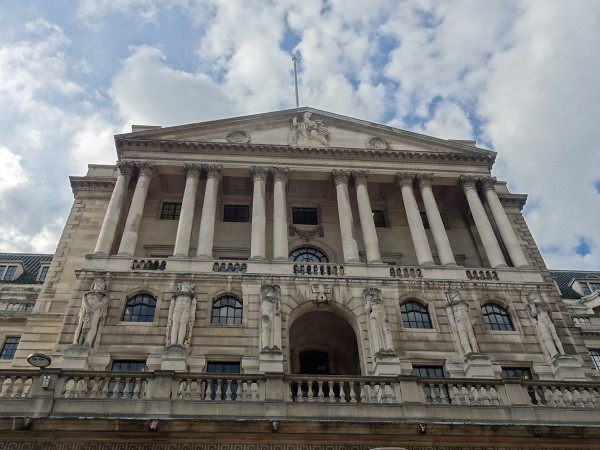 When UK unemployment was 7.7% in July 2013, Mark Carney, the newly arrived governor of the Bank of England, said that the Bank would probably have to rise interest rates when the unemployment rate dropped below 7%. Below that rate, it was expected that inflation would rise. In other words, 7% was the NAIRU – the non-accelerating rate of inflation. The most recent figure for the unemployment rate is 4.8% and yet the Bank of England has not raised interest rates. In fact, in response to the Brexit vote, it cut Bank Rate from 0.5% to 0.25% in August last year. (Click here for a PowerPoint of the chart below.)
When UK unemployment was 7.7% in July 2013, Mark Carney, the newly arrived governor of the Bank of England, said that the Bank would probably have to rise interest rates when the unemployment rate dropped below 7%. Below that rate, it was expected that inflation would rise. In other words, 7% was the NAIRU – the non-accelerating rate of inflation. The most recent figure for the unemployment rate is 4.8% and yet the Bank of England has not raised interest rates. In fact, in response to the Brexit vote, it cut Bank Rate from 0.5% to 0.25% in August last year. (Click here for a PowerPoint of the chart below.)
The NAIRU is a similar, although not identical, concept to the natural rate of unemployment. The natural rate is the equilibrium rate consistent with an overall long-term balance of aggregate labour demand and supply: i.e. the rate after short-term cyclical movements in unemployment have been discounted. It is thus a long-term concept.
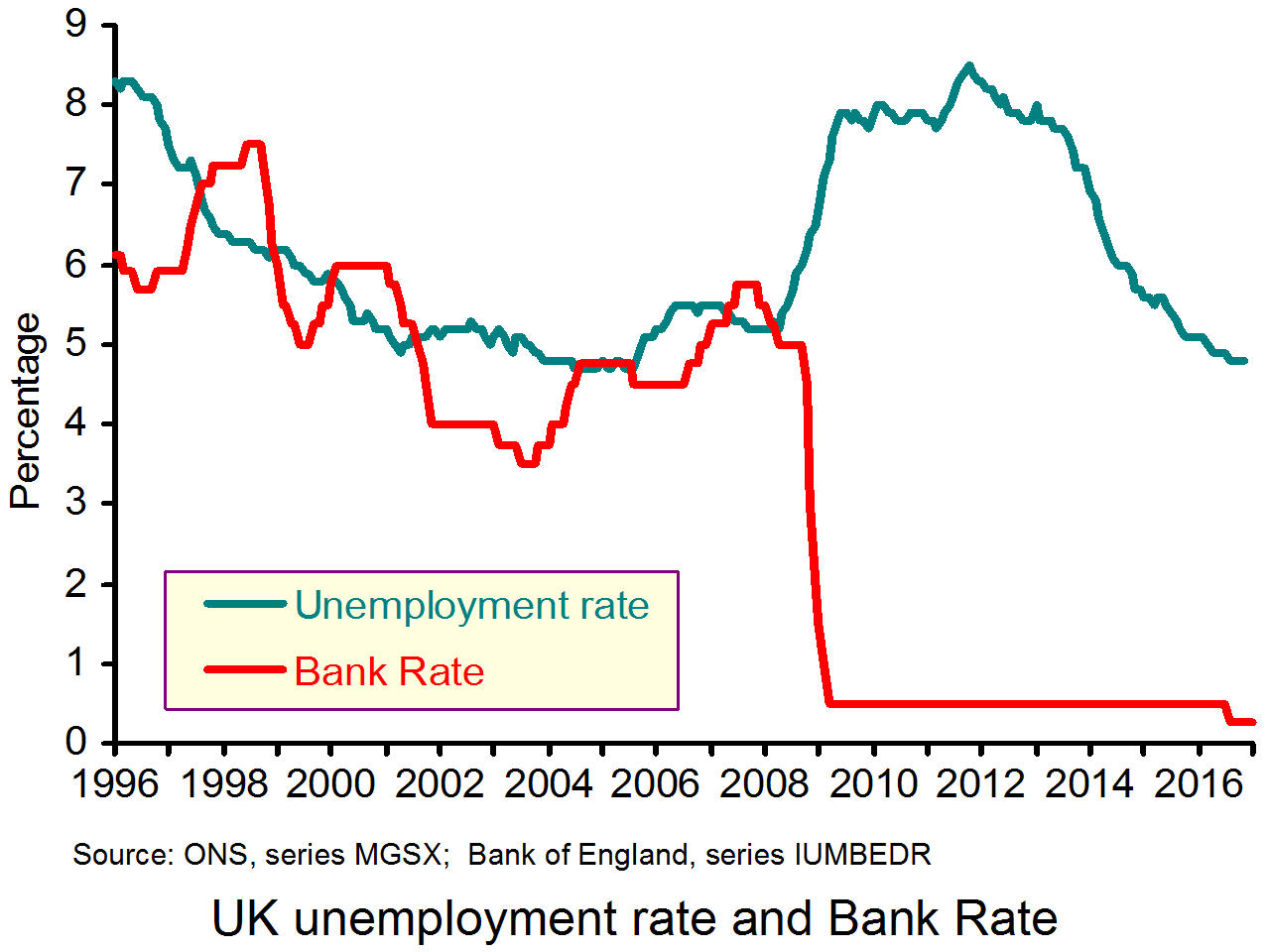 The NAIRU, although similar, focuses on the relationship between inflation and unemployment. With inflation caused solely by demand-side factors, the natural rate and the NAIRU will be similar if not identical. However, if cost-push factors change – say there is a poor harvest, which pushes up food prices and inflation (temporarily), or a substantial depreciation of the exchange rate caused by political factors (such as Brexit) – the NAIRU would increase, at least in the short term, as a higher rate of unemployment would be necessary to stop inflation rising. In the long term, although being defined differently, the NAIRU and the natural rate will be the same.
The NAIRU, although similar, focuses on the relationship between inflation and unemployment. With inflation caused solely by demand-side factors, the natural rate and the NAIRU will be similar if not identical. However, if cost-push factors change – say there is a poor harvest, which pushes up food prices and inflation (temporarily), or a substantial depreciation of the exchange rate caused by political factors (such as Brexit) – the NAIRU would increase, at least in the short term, as a higher rate of unemployment would be necessary to stop inflation rising. In the long term, although being defined differently, the NAIRU and the natural rate will be the same.
In practice, because the Bank of England is targeting inflation at a 24-month time horizon, the NAIRU for the UK at that point could also be seen as the natural rate.
So with the Bank of England not raising interest rates despite the considerable fall in the unemployment rate, does this imply a fall in the natural rate of unemployment? The answer is yes. The reason has to do with changes in the structure of the labour market.
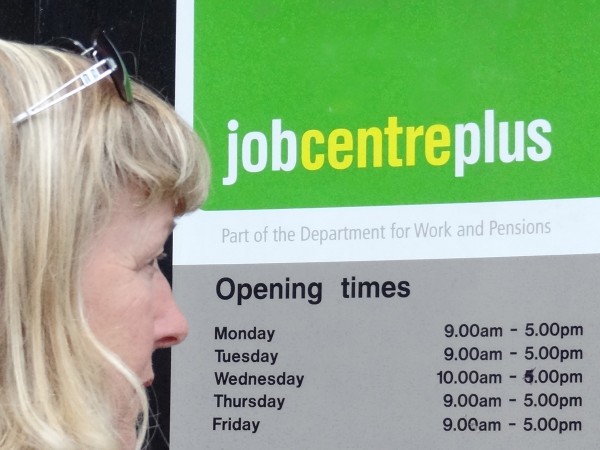 The proportion of young people and women with children returning to the labour market has fallen. Such people have a higher-than-average rate of unemployment since they typically spend a period of time searching for a job.
The proportion of young people and women with children returning to the labour market has fallen. Such people have a higher-than-average rate of unemployment since they typically spend a period of time searching for a job.
Tax and benefit reforms over the years have increased the incentive for the unemployed to take work.
Perhaps the biggest factor is a greater flexibility in the labour market. As union power has waned and as people are increasingly working on flexible contracts, including zero-hour contracts, so this has moderated wage increases. At the same time, many firms are facing increased competition both from abroad and domestically via the Internet. This has put downward pressure on prices and hence on the wages firms are willing to pay.
 The effect has been a fall in the NAIRU and probably the natural rate. Frictions in the labour market have reduced and people losing their jobs because of changes in industrial structure find it easier to get jobs in low-skilled service industries, where employers’ risks of taking on such workers have fallen because of the loss of rights for such workers.
The effect has been a fall in the NAIRU and probably the natural rate. Frictions in the labour market have reduced and people losing their jobs because of changes in industrial structure find it easier to get jobs in low-skilled service industries, where employers’ risks of taking on such workers have fallen because of the loss of rights for such workers.
So what is the natural rate of unemployment today? It is certainly much lower than 7%; the consensus is that it is probably below 5%. As Kristin Forbes, External MPC Member of the Bank of England stated in a recent speech:
[Unemployment] is forecast to increase gradually from its current 4.8% to a high of 5.0% in the second half of 2017, before falling back to its current rate by the end of 2019. To put this in context, 5.0% was previously believed to be around the UK’s natural rate of unemployment – the rate below which unemployment could not fall without wages picking up to levels inconsistent with sustaining inflation around the 2% target. Unemployment at 5.0% is also below the average unemployment rate for the UK over the pre-crisis period from 1997 to 2007 (when it was 5.5%).
She went on to discuss just what the figure is for the natural, or ‘equilibrium’, rate of unemployment (U*). One problem here is that there is considerable uncertainty over the figure in the current forecast made by the Bank.
[An] assumption in the forecast about which there is substantial uncertainty is of the equilibrium unemployment rate – or U* for short. Since I have been on the MPC, the Committee has assumed that U* was around 5%. This implied that the more by which unemployment exceeded 5%, the more slack existed in the economy, and the less upward momentum would be expected in wages (controlling for other factors, such as productivity growth).
 As part of our annual assessment of regular supply-side conditions this January, Bank staff presented several pieces of analysis that suggested U* may be lower than 5% today [see, for example]. The majority of the MPC voted to lower our estimate of U* to 4.5%, based partly on the persistent weakness of wage growth over the past few years after accounting for other factors in our models. [See page 20 of the February 2017 Inflation Report.]
As part of our annual assessment of regular supply-side conditions this January, Bank staff presented several pieces of analysis that suggested U* may be lower than 5% today [see, for example]. The majority of the MPC voted to lower our estimate of U* to 4.5%, based partly on the persistent weakness of wage growth over the past few years after accounting for other factors in our models. [See page 20 of the February 2017 Inflation Report.]
My own assessment, however, suggested that although U* was likely lower than 5% today, it is likely not as low as 4.5%. If true, this would suggest that there is less slack in the economy than in the MPC’s central forecast, and wage growth and inflation could pick up faster than expected.
Against that, however, uncertainty related to Brexit negotiations could make firms more cautious about raising wages, thereby dampening wage growth no matter where unemployment is relative to its equilibrium. Moreover, even if we could accurately measure the level of U* in the economy today, it could easily change over the next few years as the labour force adjusts to any changes in the movement of labour between the UK and European Union.
Determining the precise figure of the current natural rate of unemployment, and predicting it for the medium term, is very difficult. It involves separating out demand-side factors, which are heavily dependent on expectations. It also involves understanding the wage elasticity of labour supply in various markets and how this has been affected by the increased flexibility of these markets.
Articles
When will Britons get a pay rise? The Guardian, Phillip Inman (26/2/17)
BoE decision, Inflation Report – Analysts react DigitalLook, Alexander Bueso (2/2/17)
Bank of England hikes UK economic growth forecasts but warns of rising inflation The Telegraph, Szu Ping Chan (2/2/17)
Bank of England publications
Inflation Report Bank of England (February 2017)
A MONIAC (not manic) economy Bank of England Speeches, Kristin Forbes (8/2/17)
The labour market Bank of England Speeches, Michael Saunders (31/1/17)
Questions
- Distinguish between the following terms: natural rate of unemployment, NAIRU, equilibrium rate of unemployment, disequilibrium rate of unemployment.
- For what reasons did the Monetary Policy Committee members feel that the equilibrium rate of unemployment might be as low as 4.25%?
- Why might it be as high as 5%?
- How are changes in migration trends likely to affect (a) wage growth and (b) unemployment?
- How is the amount of slack in an economy measured? What impact does the degree of slack have on wage growth and inflation?
- What is meant by the ‘gig’ economy? How has the development of the gig economy impacted on unemployment and wages?
- Why has there been a considerable rise in self employment?
- How may questions of life style choice and control over the hours people wish to work impact on the labour market?
- If people are moving jobs less frequently, does this imply that the labour market is becoming less flexible?
- Why may firms in the current climate be cautious about raising wages even if aggregate demand picks up?
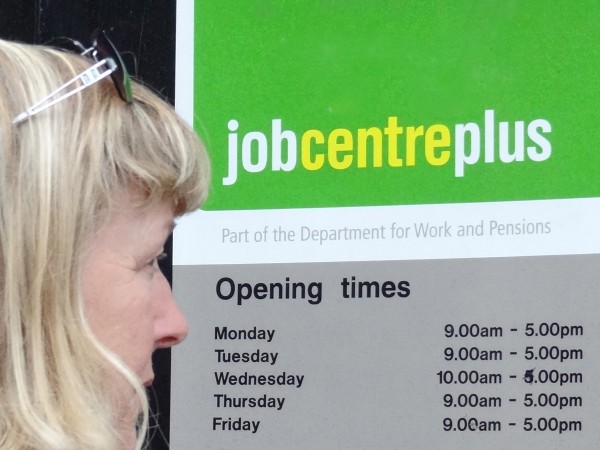 Unemployment and employment are concepts that are often talked about in the media. Indeed, the 7% unemployment target referred to by the Governor of the Bank of England has been a constant feature of recent headlines. However, rather than targeting an unemployment rate of 7%, George Osborne has now called for ‘full employment’ and believes that tax and welfare changes are key to meeting this objective.
Unemployment and employment are concepts that are often talked about in the media. Indeed, the 7% unemployment target referred to by the Governor of the Bank of England has been a constant feature of recent headlines. However, rather than targeting an unemployment rate of 7%, George Osborne has now called for ‘full employment’ and believes that tax and welfare changes are key to meeting this objective.
Reducing the unemployment rate is a key macroeconomic objective and the costs of unemployment are well-documented. There are obviously big costs to the individual and his/her family, including lower income, dependency, stress and potential health effects. There are also costs to the government: lower income tax revenues, potentially lower revenues from VAT through reduced consumer expenditure and the possibility of higher benefit payments. There are other more ‘economic’ costs, namely an inefficient use of resources. Unemployment represents a cost to the economy, as we are operating below full capacity and we therefore see a waste of resources. It is for this reason that ‘full employment’ is being targeted.
Traditional economic theory suggests that there is a trade-off between unemployment and inflation, illustrated by the well-known Phillips curve. In the past, governments have been willing to sacrifice unemployment for the purpose of reducing inflation. There have also been attempts to boost the economy and create jobs through increased borrowing. However, George Osborne has said:
Unemployment is never a price worth paying, but artificial jobs paid for with borrowed money doesn’t work either.
A figure representing full employment hasn’t been mentioned, so it remains unclear what level of unemployment would be acceptable, as despite the name ‘full employment’, this doesn’t mean that everyone has a job. There are several definitions of full employment, in both an economic and political context. In the period of reconstruction after the Second World War, William Beveridge, architect of the welfare state, defined full employment as where 3% of people would be unemployed.
In more recent times, other definitions have been given. In the era of monetarism in the 1970s, the term ‘natural rate of unemployment’ was used to define the unemployment rate to which economies tend in the long run – after inflationary expectations have adjusted. Keynesians use the term the ‘non-accelerating-inflation rate of unemployment (NAIRU)’, where unemployment is confined to equilibrium unemployment and where there is no excess or deficiency of aggregate demand. Both the natural rate and the NAIRU relate to the rate of unemployment at which the long-run Phillips curve is vertical.
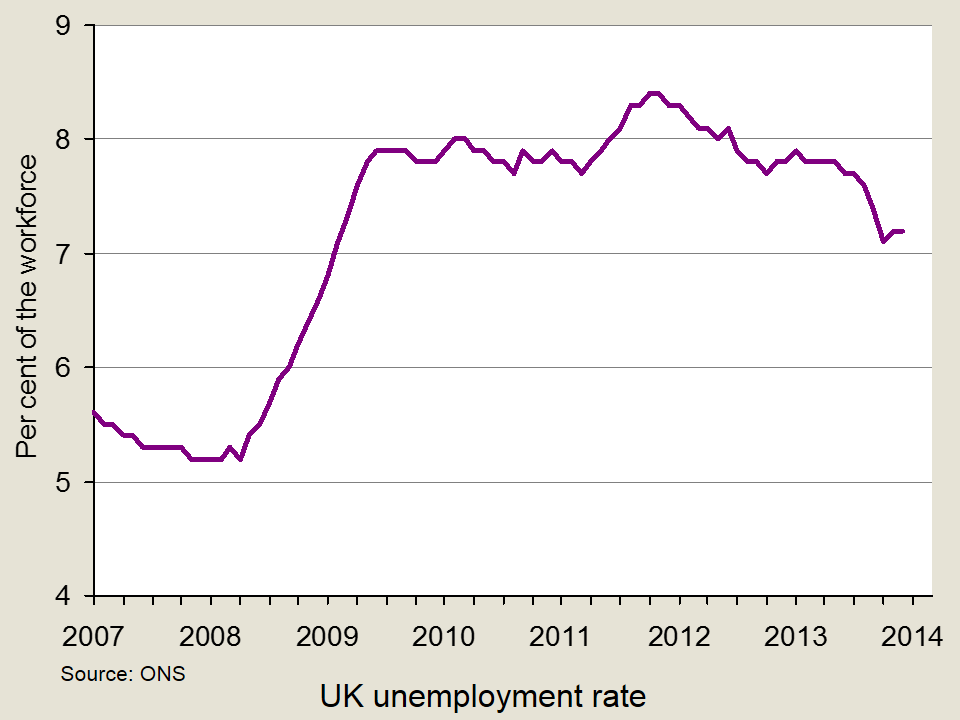
In its Economic and Fiscal Outlook of March 2013, the Office for Budget Responsibility estimated the UK’s NAIRU to be 5.4%. George Osborne has not specified a particular rate. Rather, his speech refers to creating the ‘highest employment rate of any of the world’s leading economies’. He said the ambition was to make the UK:
…the best place in the world to create a job; to get a job; to keep a job; to be helped to look for another job if you lose one…A modern approach to full employment means backing business. It means cutting the tax on jobs and reforming welfare.
Therefore, while it appears that there is no target figure for unemployment, it seems that a new Conservative objective will be to focus on sustainable job creation and eliminate disequilibrium unemployment. This represents a move very much into Labour territory. Meeting the objective will be no easy task, given the past few years and such high levels of youth unemployment, as Labour were quick to point out, but the unemployment figures are certainly moving in the right direction. The following articles consider the objective of full employment.
Articles
Britain’s Osborne changes tone on economy with “full employment” target Reuters, William James (31/3/14)
George Osborne commits to ‘fight for full employment’ BBC News (including video) (1/4/14)
What does full employment mean? The Guardian (1/4/14)
What is full employment? The Telegraph, Peter Dominiczak (31/3/14)
’Jobs matter’, says George Osborne as he aims for full employment Independent, Andrew Grice (31/3/14)
Liam Bynre: Labour would aim for ‘full employment’ BBC News (17/5/13)
Osborne pledges full employment for UK Sky News (31/3/14)
Osborne commits to full employment as election looms Bloomberg, Svenja O’Donnell (31/3/14)
Whatever happened to full employment? BBC News, Tom de Castella and Caroline McClatchey (13/10/11)
Questions
- What is meant by full employment?
- Is it a good idea to target zero unemployment?
- Using a diagram, illustrate the difference between disequilibrium and equilibrium unemployment?
- How can full employment be achieved?
- What are the costs of unemployment?
- Use a diagram to illustrate the natural rate of unemployment and explain what it means in terms of the relationship between unemployment and inflation.
 Tight fiscal policies are being pursued in many countries to deal with high public-sector deficits that resulted from the deep recession of 2008/9. This has put the main onus on monetary policy as the means of stimulating recovery. As a result we have seen record low interest rates around the world, set at only slightly above zero in the main industrialised countries for the past 4½ years. In addition, there have been large increases in narrow money as a result of massive programmes of quantitative easing.
Tight fiscal policies are being pursued in many countries to deal with high public-sector deficits that resulted from the deep recession of 2008/9. This has put the main onus on monetary policy as the means of stimulating recovery. As a result we have seen record low interest rates around the world, set at only slightly above zero in the main industrialised countries for the past 4½ years. In addition, there have been large increases in narrow money as a result of massive programmes of quantitative easing.
Yet recovery remains fragile in many countries, including the UK and much of the rest of Europe. And a new problem has been worries by potential investors that loose monetary policy may be soon coming to an end. As the June blog The difficult exit from cheap money pointed out:
The US economy has been showing stronger growth in recent months and, as a result, the Fed has indicated that it may soon have to begin tightening monetary policy. It is not doing so yet, nor are other central banks, but the concern that this may happen in the medium term has been enough to persuade many investors that stock markets are likely to fall as money eventually becomes tighter. Given the high degree of speculation on stock markets, this has led to a large-scale selling of shares as investors try to ‘get ahead of the curve’.
Central banks have responded with a new approach to monetary policy. This is known as ‘forward guidance’. The idea is to manage expectations by saying what the central bank will do over the coming months.
The USA was the first to pursue this approach. In September 2012 the Fed committed to bond purchase of $40bn per month (increased to $85bn per month in January 2013) for the foreseeable future; and record low interest rates of between 0% and 0.25% would continue. Indeed, as pointed out above, it was the ‘guidance’ last month that such a policy would be tapered off at some point, that sent stock markets falling in June.
The Fed has since revised its guidance. On 10 July, Ben Bernanke, the Fed Chairman said that monetary policy would not be tightened for the foreseeable future. With fiscal policy having been tightened, QE would continue and interest rates would not be raised until unemployment had fallen to 6.5%.
Japan has been issuing forward guidance since last December. Its declared aim has been to lower the exchange rate and raise inflation. It would take whatever fiscal and monetary policies were deemed necessary to achieve this (see A J-curve for Japan? and Japan’s three arrows).
Then on 4 July both the Bank of England and the ECB adopted forward guidance too. Worried that growth in the US economy would lead to an end to loose monetary policy before too long and that this would drive up interest rates worldwide, both central banks committed to keeping interest rates low for an extended period of time. Indeed, the ECB declared that the next movement in interest rates would more likely be down than up. Mario Draghi, the ECB president said that the ending of loose monetary policy is ‘very distant’.
The effect of this forward guidance has been to boost stock markets again. The hope is that by managing expectations in this way, the real economy will be affected too, with increased confidence leading to higher investment and faster economic growth.
 Update (8/8/13)
Update (8/8/13)
With the publication of its August 2013 Inflation Report, the Bank of England clarified its approach to forward guidance. It was announced that Bank Rate would stay at the current historically low level of 0.5% ‘at least until the Labour Force Survey headline measure of unemployment has fallen to a threshold of 7%’. In his Inflation Report Press Conference opening remarks, Mark Carney, Governor of the Bank of England, also stated that:
While the unemployment rate remains above 7%, the MPC stands ready to undertake further asset purchases if further stimulus is warranted. But until the unemployment threshold is reached the MPC intends not to reduce the stock of asset purchases from the current £375 billion.
Nevertheless, the Bank reserved the right to abondon this undertaking under cirtain circumstances. As Mark Carney put it:
The Bank of England’s unwavering commitment to price stability and financial stability is such that this threshold guidance will cease to apply if material risks to either are judged to have arisen. In that event, the unemployment threshold would be ‘knocked out’. The guidance will remain in place only if, in the MPC’s view, CPI inflation 18 to 24 months ahead is more likely than not to be below 2.5%, medium-term inflation expectations remain sufficiently well anchored, and the FPC has not judged that the stance of monetary policy poses a significant threat to financial stability that cannot otherwise be contained through the considerable supervisory and regulatory policy tools of the various authorities. The two inflation knockouts ensure that the guidance remains fully consistent with our primary objective of price stability. The financial stability knockout takes full advantage of the new institutional structure at the Bank of England, ensuring that monetary and macroprudential policies coordinate to support a sustainable recovery. The knock-outs would not necessarily trigger an increase in Bank Rate – they would instead be a prompt for the MPC to reconsider the appropriate stance of policy.
Similarly, it is important to be clear that Bank Rate will not automatically be increased when the unemployment threshold is reached. Nor is 7% a target for unemployment. The rate of unemployment consistent with medium-term price stability – a rate that monetary policy can do little to affect – is likely to be lower than this. So 7% is merely a ‘way station’ at which the MPC will reassess the state of the economy, the progress of the economic recovery, and, in that context, the appropriate stance of monetary policy.
The articles in the updated section below consider the implications of this forward guidance and the caveat that the undertaking might be abondoned in certain circumstances.
Articles
Q&A: What is ‘forward guidance’ BBC News, Laurence Knight (4/7/13)
Forward guidance crosses the Atlantic The Economist, P.W. (4/7/13)
ECB has no plans to exit loose policies, says Benoit Coeure The Telegraph, Szu Ping Chan (25/6/13)
ECB issues unprecedented forward guidance The Telegraph, Denise Roland (4/7/13)
Independence day for central banks BBC News, Stephanie Flanders (4/7/13)
The Monetary Policy Committee’s search for guidance BBC News, Stephanie Flanders (16/7/13)
The Monetary Policy Committee’s search for guidance (II) BBC News, Stephanie Flanders (17/7/13)
Bank of England surprise statement sends markets up and sterling tumbling The Guardian, Jill Treanor and Angela Monaghan (4/7/13)
Forward guidance only works if you do it right Financial Times, Wolfgang Münchau (7/7/13)
Fed’s Forward Guidance Failing to Deliver Wall Street Journal, Nick Hastings (15/7/13)
Talking Point: Thoughts on ECB forward guidance Financial Times, Dave Shellock (11/7/13)
Forward guidance in the UK is likely to fail as the Fed taper approaches City A.M., Peter Warburton (12/7/13)
Forward guidance more than passing fashion for central banks Reuters, Sakari Suoninen (11/7/13)
Markets await Mark Carney’s ‘forward guidance’ The Guardian, Heather Stewart (17/7/13)
Beware Guidance The Economist, George Buckley (25/7/13)
Articles for update
The watered down version of Forward Guidance Reuters, Kathleen Brooks (8/8/13)
Clarity Versus Flexibility at the Bank of England Bloomberg (7/8/13)
Mark Carney’s guidance leaves financial markets feeling lost Independent, Ben Chu (8/8/13)
Bank links interest rates to unemployment target BBC News (7/8/13)
Mark Carney says forward guidance should boost economy BBC News (8/8/13)
The Bank’s new guidance BBC News, Stephanie Flanders (7/8/13)
Uncertainty over BoE guidance lifts sterling to 7-week peak Reuters, Spriha Srivastava (8/8/13)
Bank of England’s guidance is clear, say most economists: Poll The Economic Times (8/8/13)
Britain’s economy: How is it really doing? The Economist (10/8/13)
Markets give thumbs down to Mark Carney’s latest push on forward guidance The Guardian, Larry Elliott (28/8/13)
Carney’s guidance on guidance BBC News, Stephanie Flanders (28/8/13)
Webcasts and podcasts for update
 Inflation Report Press Conference Bank of England (7/8/13)
Inflation Report Press Conference Bank of England (7/8/13)
 Interest rates to be held until unemployment drops to 7% BBC News, Extracts of Statement by Mark Carney, Governor of the Band of England (7/8/13)
Interest rates to be held until unemployment drops to 7% BBC News, Extracts of Statement by Mark Carney, Governor of the Band of England (7/8/13)
 Bank of England links rates to unemployment target BBC News (7/8/13)
Bank of England links rates to unemployment target BBC News (7/8/13)
 Mark Carney: Financial institutions ‘have to change culture’ BBC Today Programme (8/8/13)
Mark Carney: Financial institutions ‘have to change culture’ BBC Today Programme (8/8/13)
 Bank of England’s Mark Carney announces rates held BBC News. John Moylan (7/8/13)
Bank of England’s Mark Carney announces rates held BBC News. John Moylan (7/8/13)
Central Bank Statements and Speeches
How does forward guidance about the Federal Reserve’s target for the federal funds rate support the economic recovery? Federal Reserve (19/6/13)
Remit for the Monetary Policy Committee HM Treasury (20/3/13)
Bank of England maintains Bank Rate at 0.5% and the size of the Asset Purchase Programme at £375 billion Bank of England (4/7/13)
Monthly Bulletin ECB (see Box 1) (July 2013)
Inflation Report Press Conference: Opening remarks by the Governor Bank of England (7/8/13)
MPC document on Monetary policy trade-offs and forward guidance Bank of England (7/8/13)
Monetary policy and forward guidance in the UK Bank of England, David Miles (24/9/13)
Monetary strategy and prospects Bank of England, Paul Tucker (24/9/13)
Questions
- Is forward guidance a ‘rules-based’ or ‘discretion-based’ approach to monetary policy?
- Is it possible to provide forward guidance while at the same time pursuing an inflation target?
- If people know that central banks are trying to manage expectations, will this help or hinder central banks?
- Does the adoption of forward guidance by the Bank of England and ECB make them more or less dependent on the Fed’s policy?
- Why may forward guidance be a more effective means of controlling interest rates on long-term bonds (and other long-term rates too) than the traditional policy of setting the repo rate on a month-by-month basis?
- What will determine the likely success of forward guidance in determining long-term bond rates?
- Is forward guidance likely to make stock market speculation less destabilising?
- Is what ways is the ‘threshold guidance’ by the Bank of England likely to make the current expansionary stance of monetary policy more effective?
- Is 7% the ‘natural rate of unemployment’? Explain your reasoning.
The output gap is defined as ‘the difference between actual and potential output.’ When actual output exceeds potential output, the gap is positive. When actual output is less than potential output, the gap is negative. The size of the output gap traces the course of the business cycle. In the current recession, the output gap is negative in all major economies. The worry in recent months has been that a persistent large negative gap could lead to a downward deflationary spiral. Evidence is emerging, however, that the recession may be bottoming out and the danger of deflation easing. But just how big is the current negative output gap? As the article below from The Economist states, “Estimating how big the output gap is, and how much of a deflationary threat it still poses, is not easy.”
So how is the output gap measured in practice? How do we measure ‘potential output’? The two articles consider this issue of measurement and the relationship between the output gap and the rate of inflation. The last two links are to data sources giving estimates of the output gap. The first is from the European Commission and the second is from the OECD. As you will see, there are differences in their estimates.
Put out: Uncertainty over the size of the output gap complicates the task of central banks The Economist (2/7/09)
How big is the output gap? FRBSF Economic Letter (12/6/09)
See also:
Box 1.3.2 on page 31 and Table 13 on page 140 of European Economy: Economic Forecast, Spring 2009 European Commission, Economic and Financial Affairs (From the above link, click on the little ‘en’ symbol.)
and: Table 10 from OECD Economic Outlook No. 85, June 2009 OECD (From the above link, click on ‘Demand and output’. The first 10 tables then download as an Excel file.)
Questions
- Why is it difficult to measure potential output? (See both The Economist article and Box 1.3.2 from the European Economy: Economic Forecast, Spring 2009.)
- What is meant by the ‘NAIRU’? Why may it have risen during the recession? How would you set about estimating the value of the NAIRU?
- How might you infer the size of the output gap from the behaviour of inflation?
- Plot the output gap for two countries of your choice using data from both the European Economy and the OECD Economic Outlook for the years 2004 to 2010. Discuss the differences between (a) the two plots for each country and (b) the two countries.
 When UK unemployment was 7.7% in July 2013, Mark Carney, the newly arrived governor of the Bank of England, said that the Bank would probably have to rise interest rates when the unemployment rate dropped below 7%. Below that rate, it was expected that inflation would rise. In other words, 7% was the NAIRU – the non-accelerating rate of inflation. The most recent figure for the unemployment rate is 4.8% and yet the Bank of England has not raised interest rates. In fact, in response to the Brexit vote, it cut Bank Rate from 0.5% to 0.25% in August last year. (Click here for a PowerPoint of the chart below.)
When UK unemployment was 7.7% in July 2013, Mark Carney, the newly arrived governor of the Bank of England, said that the Bank would probably have to rise interest rates when the unemployment rate dropped below 7%. Below that rate, it was expected that inflation would rise. In other words, 7% was the NAIRU – the non-accelerating rate of inflation. The most recent figure for the unemployment rate is 4.8% and yet the Bank of England has not raised interest rates. In fact, in response to the Brexit vote, it cut Bank Rate from 0.5% to 0.25% in August last year. (Click here for a PowerPoint of the chart below.) The NAIRU, although similar, focuses on the relationship between inflation and unemployment. With inflation caused solely by demand-side factors, the natural rate and the NAIRU will be similar if not identical. However, if cost-push factors change – say there is a poor harvest, which pushes up food prices and inflation (temporarily), or a substantial depreciation of the exchange rate caused by political factors (such as Brexit) – the NAIRU would increase, at least in the short term, as a higher rate of unemployment would be necessary to stop inflation rising. In the long term, although being defined differently, the NAIRU and the natural rate will be the same.
The NAIRU, although similar, focuses on the relationship between inflation and unemployment. With inflation caused solely by demand-side factors, the natural rate and the NAIRU will be similar if not identical. However, if cost-push factors change – say there is a poor harvest, which pushes up food prices and inflation (temporarily), or a substantial depreciation of the exchange rate caused by political factors (such as Brexit) – the NAIRU would increase, at least in the short term, as a higher rate of unemployment would be necessary to stop inflation rising. In the long term, although being defined differently, the NAIRU and the natural rate will be the same. The proportion of young people and women with children returning to the labour market has fallen. Such people have a higher-than-average rate of unemployment since they typically spend a period of time searching for a job.
The proportion of young people and women with children returning to the labour market has fallen. Such people have a higher-than-average rate of unemployment since they typically spend a period of time searching for a job. The effect has been a fall in the NAIRU and probably the natural rate. Frictions in the labour market have reduced and people losing their jobs because of changes in industrial structure find it easier to get jobs in low-skilled service industries, where employers’ risks of taking on such workers have fallen because of the loss of rights for such workers.
The effect has been a fall in the NAIRU and probably the natural rate. Frictions in the labour market have reduced and people losing their jobs because of changes in industrial structure find it easier to get jobs in low-skilled service industries, where employers’ risks of taking on such workers have fallen because of the loss of rights for such workers.As part of our annual assessment of regular supply-side conditions this January, Bank staff presented several pieces of analysis that suggested U* may be lower than 5% today [see, for example]. The majority of the MPC voted to lower our estimate of U* to 4.5%, based partly on the persistent weakness of wage growth over the past few years after accounting for other factors in our models. [See page 20 of the February 2017 Inflation Report.]




